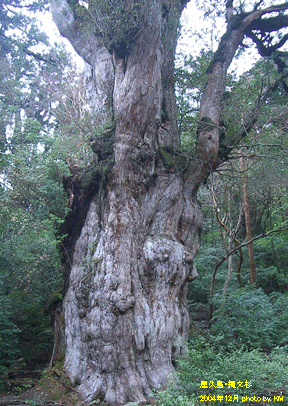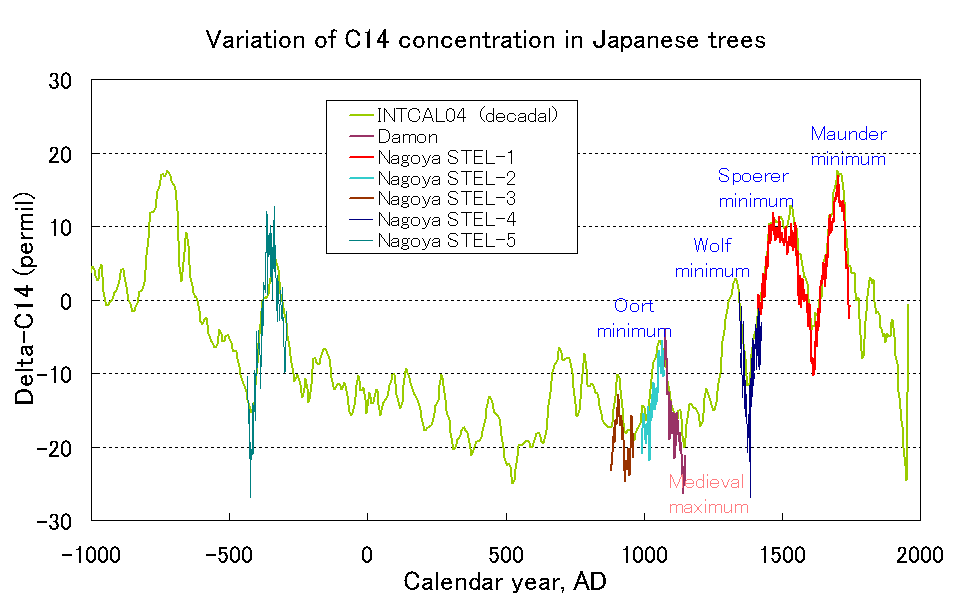Radiocarbon (14C)
Involving Research Members

- Reconstruction of Past Solar Activity Using Radiocarbon(14C)
- Outline of the Research
- Details of the Research
- Past Research Results
- Further Research
Reconstruction of Past Solar Activity Using Radiocarbon(14C)
Radiocarbon (14C) in Earth is created by cosmic rays in the Earth’s atmosphere. By measuring the concentration of 14C in the annual rings of old trees, such as the Japanese cedar, we can determine the changes in the intensity of cosmic rays in the past. We can also learn about the variation of solar activity, which controls the intensity of cosmic rays falling on the earth. Solar activity fluctuates in 11-year cycles, but how did it change in the past? We are also investigating the high-energy phenomena occurred in the past, e.g., huge solar flares and supernova explosions near the Earth, which cause a sudden input of a large amount of cosmic rays to the Earth.
Outline of the Research
We can determine the past cosmic ray intensity and solar activity by using radiocarbon (14C) produced by the reaction between the Earth’s atmosphere and Galactic cosmic rays (GCRs) reaching the Earth under the influence of solar activity Our goal is to measure radiocarbon in old tree rings with a resolution of one year to understand solar activity and cosmic environmental changes over the past several thousand years.
Details of the Research
The cosmic ray particles coming from the galactic universe are mostly protons and have a positive charge. On the other hand, the Sun produces a magnetic field by a dynamo mechanism, and its influence is widespread in the space including the solar system (heliosphere). The intensity of cosmic rays in the heliosphere is modulated by the variation of the magnetic field in the interplanetary space due to the strength of solar activity. In other words, when the sun is active, the magnetic field in the interplanetary space is stronger and its fluctuation is larger, which makes it harder for cosmic ray particles to enter the heliosphere and weakens the intensity of cosmic rays reaching the earth. Thus, there is an inverse correlation between the strength of solar activity and the intensity of cosmic rays. On the other hand, a large solar flare or coronal mass ejection can cause a large amount of energetic particles (SEPs) to be ejected (SEP event), which can significantly increase the intensity of cosmic rays on Earth.

Cosmic ray particles enter the Earth’s atmosphere and collide with atmospheric nuclei, causing reactions that produce secondary cosmic rays and many radioactive isotopes. Typical isotopes include carbon-14 (radiocarbon) and beryllium-10. Carbon 14 combines with oxygen in the atmosphere to form carbon dioxide, which circulates in the earth’s atmosphere along with normal carbon dioxide, which is composed of stable carbon isotopes (carbon 12 and carbon 13). Some of it is taken up by trees through photosynthesis, so the annual tree rings that form each year record and store the carbon 14 concentration for that year. Since carbon-14 decays with a half-life of 5730 years, the concentration of carbon-14 in the Earth’s environment is in equilibrium according to the time constant of radioactive decay and its distribution to reservoirs, such as in the Earth’s atmosphere, biosphere, and ocean. When the intensity of cosmic rays reaching the Earth changes due to changes in solar activity, the production rate of isotopes such as carbon-14 changes, and the concentration in each reservoir deviates from the equilibrium state. In the case of carbon-14, due to the value of its distribution time constant, the variation in the lower troposphere (surface) is much smaller than the variation in the production rate.
It has been pointed out that large fluctuations in solar activity, such as the Maunder Minimum, have occurred frequently over the past thousand to ten thousand years. By measuring the carbon-14 concentration in the annual rings of long-gone trees such as the Japanese cedar in the Yakushima-island, we are trying to determine whether such solar activity minima really occurred and to investigate their characteristics in detail. We are also searching for traces of extreme SEP events that occurred in the past.
Past Research Results

Our group has studied Carbon-14 concentrations mainly during solar activity minima, such as the Maunder Minimum (1645-1715 AD), the Spoelar Minimum (1416-1534 AD), and the 4th century BC Minimum. As a result, we showed the possibility that solar activity, which currently fluctuates with an average cycle of 11 years, fluctuated with a cycle of 14 years during the Maunder Minimum, and with a cycle of 15 to 16 years during the 4th century BC Minimum. On the other hand, in the Spoelar minimum, the period was 11 years, and it has become clear that the characteristics of solar activity might differ in each minimum period. Thus, solar activity in the past has complex characteristics. In addition, we are measuring the carbon-14 concentrations of other minima with a time resolution of one year to investigate their periodicity.
We also found a sharp increase in carbon-14 concentrations between 774 and 775 AD and between 993 and 994 AD, indicating that the incoming cosmic rays increased significantly during these periods. We have measured the beryllium-10 concentrations in the Antarctic Dome Fuji ice core for the two events, and have shown that these cosmic ray events have been caused by extreme SEP events that were much larger than the largest SEP event on record.
Further Research
If an extreme solar explosion like the 775 AD event were to occur today, it would have a major impact on our lives, such as the failure of satellites. We are searching for further traces of past extreme SEP events to estimate the frequency of extreme SEP events. In addition, by studying the basic solar variables (11-year Schwabe cycle and 22-year Hale cycle), we aim to clarify the causes of solar activity variability, which will lead to future predictions of solar activity.